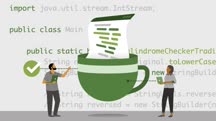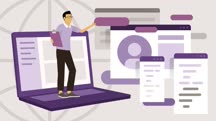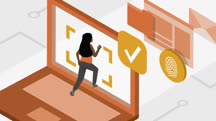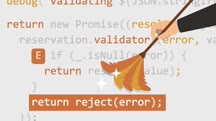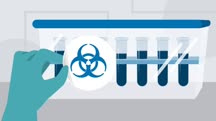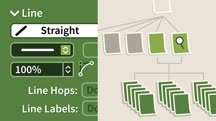Course catalog
Categories
Showing 1,021-1,040 of 1,450 items.
Moving Past Change Fatigue to the Growth Edge (230058)
Disruption creates opportunities. When employees and leaders are mired in a crisis, they often find innovative ways to tackle old processes. But how can organizations sustain the pace of change without triggering burnout? In this course, instructor Charlene Li shows you how, explaining how to stretch people to reach for audacious growth without stressing them out. Charlene shares how to define clear boundaries, so that teams feel comfortable leaving their comfort zone and working at the edge. She identifies the critical structures and processes to put in place to create growth with stability. Plus, she shares tips for combatting change fatigue, including how to set stretch goals and keep the focus on your future customers.
Multi-Shot Photo Techniques in Photoshop and Lightroom (226012)
You may be a master of editing single photos, but multi-shot photo techniques like panos, HDR, and focus stacks present some unique challenges. In this course, graphic designer Nigel French shows you all the basics of using Lightroom, Photoshop and Bridge to achieve great results with techniques that use multiple shots. Beginning with panoramas. Nigel walks you through shooting panoramas, then explains how to create them in Photoshop, Lightroom Classic, and Adobe Camera RAW (ACR). He discusses different projections, common problems that can occur, and some unexpected uses of panoramas, including making an Instagram carousel. Then Nigel moves on to creating HDR images in Lightroom Classic, Photoshop, and ACR. After covering several practical techniques to stack, blend, and combine layers, Nigel concludes with additional effects that you can achieve by stacking layers.
Nail Your Java Interview (221031)
Have you lined up an interview for a Java developer position? In this course, review critical Java concepts-and commonly-asked interview questions-to ensure that you approach your Java interviews with confidence. Instructor Kathryn Hodge dives into a discussion of key topics that might appear as questions in an interview, such as the difference between the Java Runtime Environment (JRE) and the Java Development Kit (JDK). She also goes over string manipulation, data structures, and essential object-oriented programming concepts. Throughout the course, Kathryn offers examples that lend a real-world context to the concepts she covers.
Navigating New Professional and Social Norms When Offices Reopen (216390)
As millions of people head back to schools and workplaces, the world hopes for a return to normal. But work may never be quite the same. Join etiquette expert, Jodi Smith, as she shares tips, tricks, strategies, and ideas for making your return to the workplace as positive as possible. Explore how to navigate new expectations for social distancing, setting and communicating boundaries, and interacting with colleagues when offices reopen. Plus, learn tips for being flexible, reducing stress, and re-establishing relationships with coworkers.
Networking Foundations: IP Addressing (209522)
The IP address is a fundamental building block for a functioning modern network. In this course, instructor Anthony Sequeira explains the basics of IP addressing, the components of an IP address, aggregation, and more. Anthony begins by describing what the IP address does and why it is critical in a successful network. He goes into the structure of IPv4 and IPv6 addresses. Anthony shows you how to work with the classful addressing system for IP addresses, then goes over subnet masks and subnet addressing. He covers how variable length subnet masking (VLSM) permits the creation of optimal "right-sized" network segments. Anthony walks you through CIDR and IP address aggregation. He explains special use addresses, then concludes with how IP services such as DHCP, DNS, and NAT can benefit your network.
Networking Foundations: Protocols and CLI Tools (219790)
Protocols are the lifeblood of network communications. Every website, email, and electronic bank transaction depends on them. One of the core responsibilities for any IT and networking professional is troubleshooting network connections. This course introduces the main methods for troubleshooting network connectivity issues using different protocols and command-line (CLI) tools. Networking expert Greg Sowell covers HTTP and HTTPS, the protocols that deliver websites; shows how domain names are resolved via DNS; and explains how voice traffic is carried over a network with VoIP. Greg shows how to examine all these connections and their traffic using CLI tools such as ipconfig, ping, ARP, and Telnet. By the end of this course, you'll be better prepared to troubleshoot any network connection and keep the communication flowing.
Next Generation AI: An Intro to GPT-3 (220810)
Are you an AI specialist, a data scientist, a business leader, or someone who would like to know more about how artificial intelligence is impacting our world? In this course, instructor Dr. Jonathan Reichental introduces you to a hot topic in AI development: the GPT-3 (Generative Pre-trained Transformer 3) technology released by Open AI. Reichental describes the increasingly important role that AI is playing in business. He covers a brief history of AI, then tells you about how OpenAI got started, its mission and vision, and its unique charter. Reichental discusses the core concepts of GPT-3, how it adds value, and a few of its challenges and limitations. He describes the future of AI, then concludes with suggestions for next steps you and your organization can take relative to GPT-3 and AI.
No-Code Solutions for Websites and Apps (233407)
Got a brilliant idea for a mobile application or website? Even if you've never touched a code editor in your life, you can still make your concept a reality using one of the many no-code tools currently on the market. In this course, get a broad overview of some of the options available for designing and creating websites and applications without involving (much, if any) code and engineering. Instructor Jen Kramer explains what the current market of no-code website editors looks like, as well as the benefits and limitations of opting for a no-code toolset. She also breaks down the most popular platforms and tools that support no-code development. Learn how to build web apps with Bubble, generate mobile apps with Thunkable, make interactive content with Outgrow, and more. Tune in to get acquainted with some of the latest and greatest tools in the no-code universe.
Node: Authentication (219739)
If you have a website, you want visitors. And if you run a business through a website, you want those visitors to be customers. To do that, you need user registration and authentication. Authentication is the foundation of most web applications, letting you determine who is visiting your site and helping you connect them with privileges they should or should not have. In this course, Daniel Khan shows how to add user registration and authentication to an app built with Node.js and Express.js. He covers everything from simple logins using a username and password stored in a database to more complex login methods like single sign-on. Daniel teaches this hands-on course with realistic sample projects, so that you can apply this knowledge to your own work right away.
Node.js: Testing and Code Quality (220164)
Most software engineers would agree that clean code is easier to maintain than messy code, but what exactly does that look like, and how do go about cleaning up messy code? In this course, Jon Peck shows how to measure quality, implement testing, and measure code coverage in your Node.js apps, using a complete but buggy restaurant booking application to illustrate the concepts. Jon first reviews JavaScript fundamentals and testing and code quality concepts. He then explains how to use linters to find suspicious code; explores different testing frameworks and their components; and shows how to isolate your code for testing using test doubles, then verify with spies and mocks. Jon wraps up the course by showing how to generate reports on code health across your entire codebase. Along the way, he provides challenge and solution videos so you can test your knowledge of each section before moving on.
NoSQL Essential Training (220912)
As the shiny new object in the data world, you might have heard a lot of people talk excitedly about NoSQL and all the things it can do. It’s great in terms of flexibility, speed, and is easy to work with. It’s super scalable, so it can accommodate increased numbers of users as websites and applications grow. But will it replace SQL? Will it make relational databases obsolete? In this course, Mel McGee explains just exactly what NoSQL is, the pros and cons, and tradeoffs you’ll make when using NoSQL. Mel takes a high-level approach without delving into the details of any one NoSQL query language or solution, so if you’re a developer looking for a bigger picture of NoSQL, or an entrepreneur wanting to explore options for your product, or just plain curious about non-relational databases, this course is for you.
Object-Oriented Programming with Java (163962)
It’s not too hard to write functional code in Java. But to take advantage of its object-oriented features, it requires a leap in understanding. If you're ready to take your Java skills to the next level, join engineer and Java expert June Clark in this course. Brush up on the details of objects, and then how to leverage advanced concepts such as inheritance, polymorphism, and encapsulation to build more sophisticated and efficient web projects. June reviews getters and setters and static methods, and shows how to document your code with UML. By the end of this course, you’ll have the confidence and skills to go build great things with Java.
This course was created by Madecraft. We are pleased to host this content in our library.

This course was created by Madecraft. We are pleased to host this content in our library.

Occupational Safety and Health: Blood-Borne Pathogens (233356)
Bloodborne pathogens are infectious microorganisms in human blood that can cause disease. These pathogens include, but are not limited to, hepatitis B (HBV), hepatitis C (HCV), and human immunodeficiency virus (HIV). The risk of developing the diseases caused by these pathogens occurs when you are exposed to blood that contains them. In this course, instructor Jim Rogers walks you through the various blood-borne hazards, ways to prevent infection, and some special considerations for various industries. Jim explains what a blood-borne pathogen is and what exposure means. He goes over several methods of prevention infection, including universal precautions, preventative vaccinations, PPE, and post-exposure procedures. Jim finished up with some special considerations for industries such as healthcare, first response, and construction.
Occupational Safety and Health: Hazard Communication (221864)
Many workplaces around the world are subject to regulations requiring the employer to tell all employees about the chemicals they are working with or may be exposed to. This is often called "the right to know." Many common chemicals and products fall under these right to know requirements. In this course, instructor Jim Rogers shows you how to properly communicate this information to everyone in the workplace, so they understand what precautions to take and how to keep themselves safe. Jim begins by explaining the right to know, then goes into a detailed discussion of different hazardous substances in the workplace. He covers ways to categorize hazards, as well as pictograms that alert the user to the hazards and what precautions they need to take. After stepping through how to build and understand a hazard communication (HazCom) program, Jim concludes with special considerations for several industries such as construction, pharmacies, and chemical processors.
Occupational Safety and Health: Slips, Trips, and Falls (223598)
No workplace is immune from accidents. From worksites full of hazards like construction sites or warehouses, to seemingly benign places like your average office, accidents just happen. And while you may not spend your days worrying about slips, trips, or short falls, these are some of the most frequent injuries and can be serious enough to require medical attention and time off work.
In this course, construction safety consultant Jim Rogers covers slips, trips, and falls, where they tend to occur, and their impact on the employee and the workplace. Jim provides an understanding of how both working conditions and physical structure of the jobsite can present hazards, and details policies, practices, and technology (such as personal protective equipment) that can limit the danger.
In this course, construction safety consultant Jim Rogers covers slips, trips, and falls, where they tend to occur, and their impact on the employee and the workplace. Jim provides an understanding of how both working conditions and physical structure of the jobsite can present hazards, and details policies, practices, and technology (such as personal protective equipment) that can limit the danger.
Occupational Safety and Health: Working in the Heat (233526)
Every year, as the seasons change and temperatures rise, people who work outdoors or in extreme heat—fields ranging from construction, agriculture, landscaping, and mining to the military and sports teams—succumb to various levels of heat illnesses, ranging from uncomfortable rashes and cramps, to possibly fatal heat strokes. In this course, construction safety consultant Jim Rogers explains techniques used by OSHA and NIOSH to mitigate the risks of working in heat. Jim has applied these techniques on client jobsites where temperatures have regularly exceeded 110 degrees, and knows firsthand how to calculate and assess the risks of extreme temperatures. This course also reviews the different types of heat illnesses, along with the signs, symptoms, and treatments. Whether you're a safety and health manager, you manage a group of people who work or train in the heat, or you work or train in the heat yourself, this course teaches you key practices to stay safe and healthy.
Office 365 for Educators (230942)
Microsoft Office is a staple set of tools for educators, and now includes education-specific functionality such as classroom notebooks in OneDrive and educator-specific collaboration tools in Teams. In education, learning to use these applications can help increase learning, empower students, and save teachers valuable time. This course dives into tips and tricks that will allow educators to get the most from the entire Office suite. Instructor Oliver Schinkten explores each of the Office tools: classics like PowerPoint, Excel, and Word, as well as new additions such as Sway, OneDrive, OneNote, and Teams. He demonstrates education-specific techniques and ideas to help educators create more dynamic lessons, assess student progress, share files online, and even save time. He also shares sample workflows that illustrate how Microsoft 365 Education apps can help you share key information with students and host both synchronous and asynchronous lessons.
OmniGraffle for UX and Brainstorming (222034)
In this course, Jason Osder explains what OmniGraffle is, how to create and export projects in it, and how to use OmniGraffle for general design thinking projects, as well as brainstorming, ideation, and collaboration. After briefly introducing OmniGraffle and its interface, Jason dives into org charts, covering topics like how to handle objects on the canvas, creating text elements, grouping objects, and much more. Next, he goes into a variety of techniques you can use to map content, as well techniques for process flows such as creating multiple use case scenarios and diagramming a complex online interaction. Jason discusses wireframes and different ways you can use them. Then he describes how to create mind maps, sketch visual design ideas, and design a rough logo with stencils. Jason concludes by highlighting several useful features that are available in the pro version of OmniGraffle.
On-the-Spot Business Headshots (224346)
Imagine this: it’s your first day at a new job, and someone from HR tells you to stand up against a wall and smile, as they simultaneously snap a picture of you mid blink. Congratulations—this is the ID photo that will live on in infamy on your badge for as long as you're employed at the company. As a professional headshot photographer for 15+ years, Kristina Sherk has heard all sorts of horror stories about this exact welcome-to-the-team ritual. In this course, Kristina addresses all the dos and (definitely) don’ts of corporate headshot photography. Whether you're the photographer or the subject, this course can show you how to make this experience as enjoyable as possible, while significantly improving the quality of your headshots. Learn how to get great results when taking both outdoor and indoor headshots, whether you're working without gear or with the best equipment on the market.
This course was created by RHED Pixel. We're pleased to host this training in our library.
This course was created by RHED Pixel. We're pleased to host this training in our library.
Onboarding and Adoption Best Practices for Customer Success Management (232149)
Onboarding and adoption are two of the essential activities for new customers that CSMs are responsible for. Learn how to guide customers through these two important stages, and prepare them for the upcoming value generation and realization work that lies ahead of them if they are going to attain successful outcomes from using your company's solutions. This course takes customer success managers through the processes and steps needed to ensure that their customer's stakeholders are fully prepared and ready to proceed with making the customer's initiative successful. It then provides guidance on how to help those stakeholders to train and prepare their end users to adopt and use the solution that they purchased. This course can be taken on its own as an introduction to the topic, or as one in a series of courses from PracticalCSM.com that build upon each other to cover the entirety of CSM best practices in greater detail.


